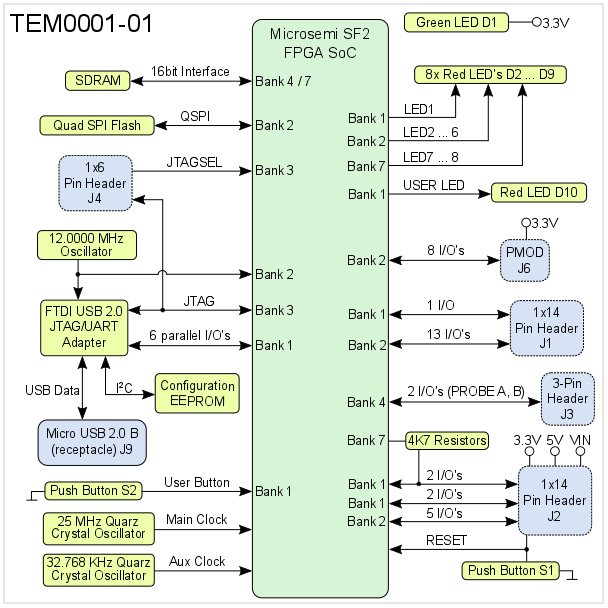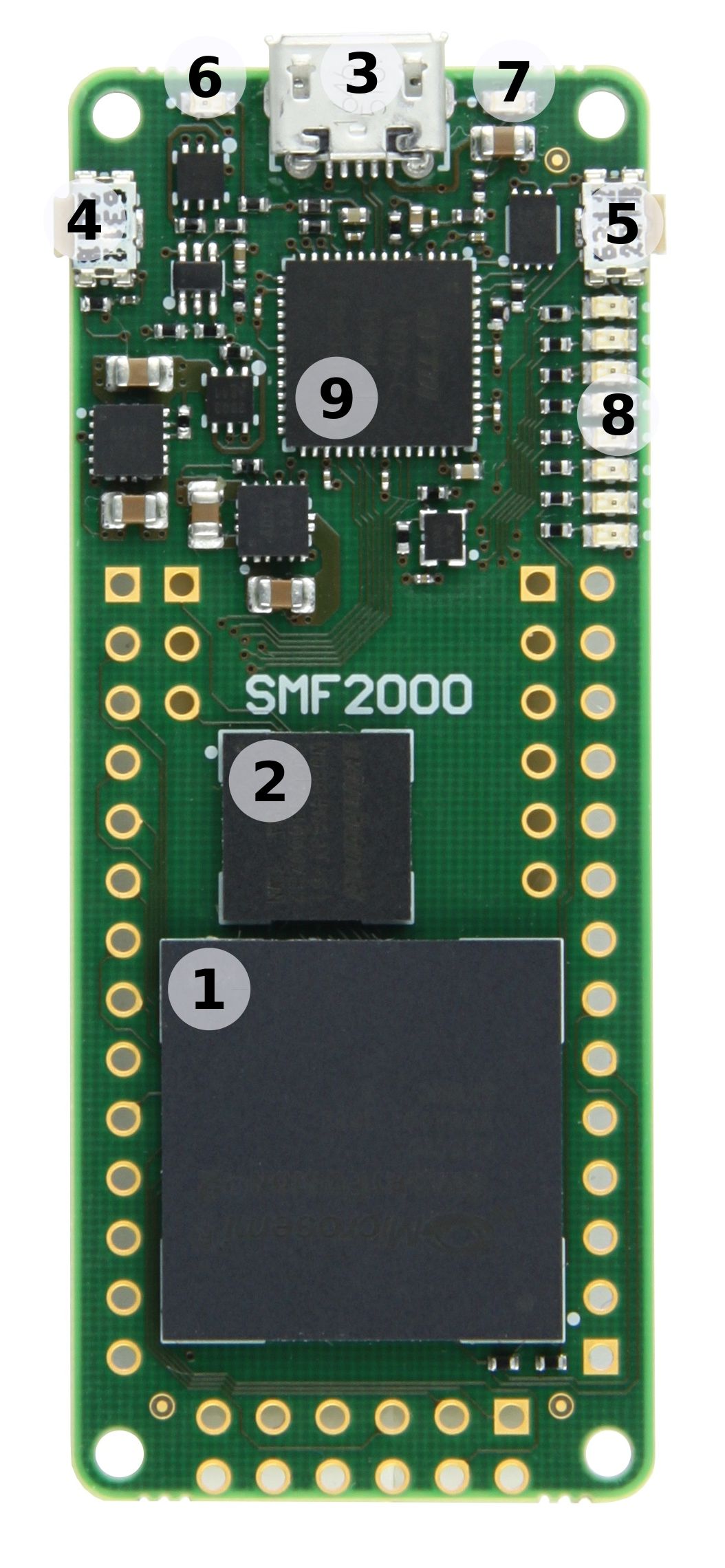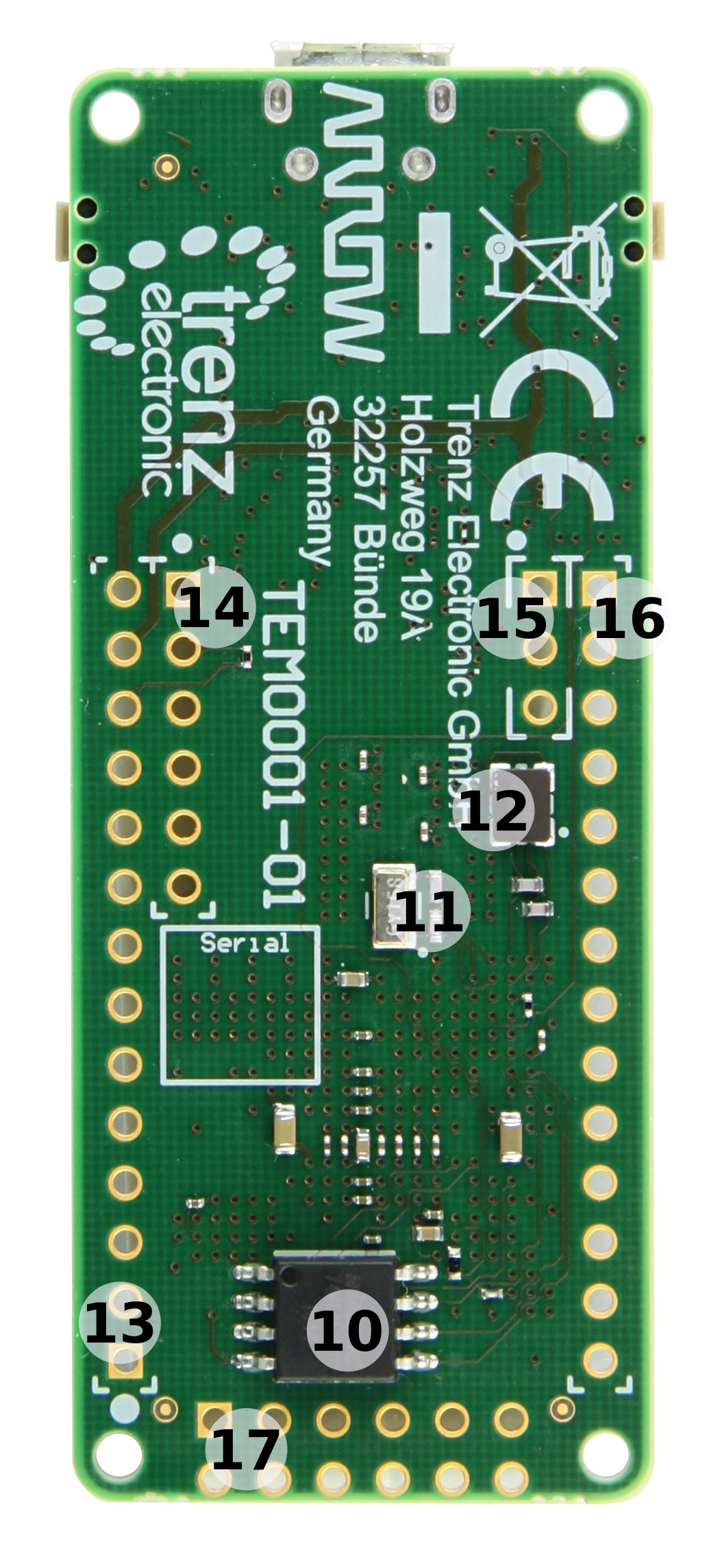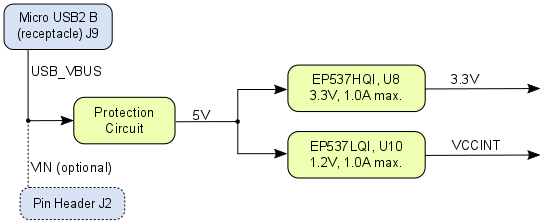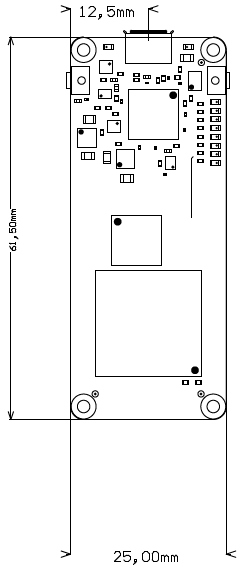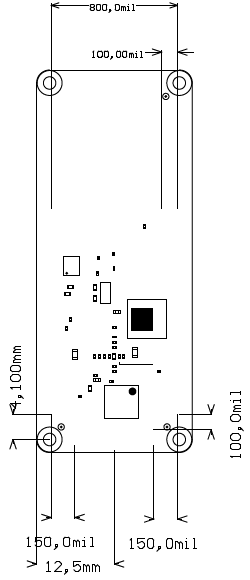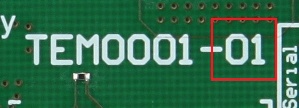Table of Contents
Overview
The Trenz Electronic TEM0001 is a low cost small-sized FPGA module integrating a Microsemi SmartFusion2 FPGA SoC and 8 MByte Flash memory for configuration and operation.
Key Features
Microsemi SmartFusion2 SoC FPGA
- 8 MByte SDRAM
8 MByte QSPI Flash memory
- 25 MHz system clock and 32.768 KHz auxiliary clock
- JTAG and UART over Micro USB2 connector
- 1x 3-pin header for Live Probes
- 1x PMOD header providing 8 GPIOs
2x 14-pin headers (2,54 mm pitch) providing 23 GPIOs
9 user LEDs
- 1 user push button
- 3.3V single power supply with on-board voltage regulators
- Size 61.5 x 25 mm
Additional assembly options are available for cost or performance optimization upon request.
Block Diagram
Figure 1: TEM0001-01 block diagram
Main Components
Figure 2: TEM0001-01 FPGA module
- Microsemi SmartFusion2 FPGA SoC, U5
- 8 Mbyte SDRAM 166MHz, U2
- Micro USB2 B socket (receptacle), J9
- Switch button (reset), S1
- Switch button (user), S2
- Red LED (user), D10
- Green LED (indicating supply voltage), D1
- 8x red LEDs (user), D2 - D9
- FTDI USB2 to JTAG/UART adapter, U3
- 8 Mbyte QSPI Flash memory, U1
- 32.768 KHz auxiliary crystal oscillator, Y1
- 25 MHz main crystal oscillator, Y2
- 1x14 pin header (2.54mm pitch), J2
- 1x6 pin header (2.54mm pitch), J4
- 3-pin header (2.54mm pitch), J3
- 1x14 pin header (2.54mm pitch), J1
- 2x6 Pmod connector, J6
Initial Delivery State
Storage device name | Content | Notes |
|---|---|---|
Quad SPI Flash (U1) OTP area | DEMO Design | - |
| I2C Configuration EEPROM, U9 | Programmed | - |
Table 1: Initial delivery state of programmable devices on the module
Boot Process
By default the configuration mode pins of the FPGA are set to QSPI mode, hence the FPGA is configured from serial Flash memory at system start-up. The JTAG interface of the module is provided for storing the initial FPGA configuration data to the QSPI flash memory.
Signals, Interfaces and Pins
I/Os on Pin Headers and Connectors
I/O signals of the FPGA SoC's I/O banks connected to the board's pin headers and connectors:
| Bank | Connector Designator | I/O Signal Count | Bank Voltage | Notes |
|---|---|---|---|---|
| 1 | J1 | 1 I/O's | 3.3V | - |
| 1 | J2 | 4 I/O's | 3.3V | 2 I/O's of bank 1 can be pulled-up to 3.3V (4K7 resistors) with 2 I/O's of Bank 7 or pins can be shared. |
| 2 | J1 | 13 I/O's | 3.3V | - |
| 2 | J2 | 5 I/O's | 3.3V | - |
| 2 | J6 | 8 /O's | 3.3V | Pmod Connector. |
| 3 | J4 | 5 I/O's | 3.3V | JTAG interface. |
| 4 | J3 | 2 I/O's | 3.3V | I/O's (PROBE A, B) are dedicated to live probes. |
| 7 | J2 | 2 I/O's | 3.3V | Those 2 I/O's are dedicated to pull-up 2 I/O's of bank 1 or pins can be shared. |
Table 2: General overview of single ended I/O signals connected to pin headers and connectors
FPGA I/O banks
| Bank | VCCIO | I/O's Count | Available on Connectors | Notes |
|---|---|---|---|---|
| 1 | 3.3V | 14 | 5 | 6 I/O's connected to FTDI chip, 1 I/O used for user button S2, 2 I/O's connected to red user LEDs D2 and D10. |
| 2 | 3.3V | 37 | 26 | 6 I/O's user for QSPI Flash, 5 I/O's connected to red user LEDs D3 ... D7. |
| 3 | 3.3V | 5 | 5 | Bank 3 is dedicated to JTAG interface. |
| 4 | 3.3V | 24 | 0 | 2 I/O's are dedicated to live probes, all other I/O's are used as memory interface. |
| 7 | 3.3V | 22 | 2 | 2 I/O's available on header J2, 2 I/O's connected to red user LEDs D8 and D9, all other I/O's are used as memory interface. |
Table 3: General overview of FPGA I/O banks
JTAG Interface
Primary JTAG access to the FPGA SoC device U5 is provided through Micro USB2 B connector J9. The JTAG interface is created by the FTDI FT2232H USB2 to JTAG/UART adapter IC U3.
Optionally 1x6 male pin header J4 can be fitted on board for access to the JTAG interface on board. The pin assignment of header J4 is shown on table below:
| JTAG Signal | Pin on Header J4 | Note |
|---|---|---|
| TCK | 3 | - |
| TDI | 5 | - |
| TDO | 4 | - |
| TMS | 6 | - |
| JTAGSEL | 2 | The JTAGSEL pin of SmartFusion2 device depends on the used JTAG programmer. |
Table 4: optional second JTAG interface or GPIO (JTAGSEL dependent)
QSPI Interface
The QSPI interface of the FPGA device is routed to and used by the on-module QSPI flash IC U1:
| SD IO Signal Schematic Name | FPGA I/O | Flash IC U1 Pin | Note |
|---|---|---|---|
| F_CS | Bank 2, pin K15 | 1 | QSPI chip select |
| F_CLK | Bank 2, pin P18 | 6 | QSPI clock |
| F_DI | Bank 2, pin P19 | 5 | QSPI data |
| F_DO | Bank 2, pin K16 | 2 | QSPI data |
| F_D2 | Bank 2, pin J18 | 3 | QSPI data |
| F_D3 | Bank 2, pin N19 | 7 | QSPI data |
Table 5: QSPI interface signals
On-board Peripherals
Quad SPI Flash Memory
On-module QSPI flash memory (U7) is provided by Winbond Serial Flash Memory W74M64FV with 64 MBit (8 MByte) storage capacity. This non volatile memory is used to store initial FPGA configuration. Besides FPGA configuration, remaining free flash memory can be used for user application and data storage.
SDRAM
The TEM0001 FPGA module is equipped with a Winbond W9864G6JT 64 MBit (8 MByte) SDRAM chip U2. This SDRAM chip is connected to the FPGA bank 4 and 7 via 16-bit memory interface with 166MHz clock frequency and CL3 CAS latency.
FTDI FT2232H IC
The FTDI chip U3 converts signals from USB2.0 to a variety of standard serial and parallel interfaces. Refer to the FTDI data sheet to get information about the capacity of the FT2232H chip.
FTDI FT2232H chip is used in MPPSE mode for JTAG, 6 I/O's of Channel B are routed to the bank 1 of the FPGA SoC and are usable for example as UART interface.
The configuration of FTDI FT2232H chip is pre-programmed on the EEPROM U9.
System Clock Oscillator
The FPGA SoC module has following reference clocking signals provided by on-board oscillators:
| Clock Source | Schematic Name | Frequency | Clock Input Destination |
|---|---|---|---|
| Microchip MEMS Oscillator, U7 | CLK12M | 12.0000 MHz | FTDI FT2232 U3, pin 3; FPGA SoC bank 2, pin N16 |
ECS SMD Crystal Oscillator, Y1 | - | 32.768 KHz | FPGA SoC U5 auxiliary clock input, pin W17/Y17 |
| AVX Quartz Crystal Oscillator, Y2 | - | 25.000 MHz | FPGA SoC U5 main clock input, pin W18/Y18 |
Table 6: Clock sources overview
On-board LEDs
There are 10 LEDs fitted on the FPGA module board. The LEDs are user configurable to indicate for example any system status.
| LED | Color | Signal Schematic Name | FPGA | Notes |
|---|---|---|---|---|
| D1 | Green | - | - | Indicating 3.3V board supply voltage |
| D2 | Red | 'LED1' | E18 | user |
| D3 | Red | 'LED2' | R17 | user |
| D4 | Red | 'LED3' | R18 | user |
| D5 | Red | 'LED4' | T18 | user |
| D6 | Red | 'LED5' | U18 | user |
| D7 | Red | 'LED6' | R16 | user |
| D8 | Red | 'LED7' | E1 | user |
| D9 | Red | 'LED8' | D2 | user |
| D10 | Red | 'USER_LED' | G17 | user |
Table 7: LEDs of the module
Push Buttons
The TEM0001 FPGA module is equipped with two push buttons S1 and S2:
| Button | Signal Schematic Name | FPGA | Notes |
|---|---|---|---|
| S1 | 'USER_BTN' | B19 | user configurable |
| S2 | 'RESET' | U17 | system reset |
Table 8: Push buttons of the module
Connectors
All connectors are are for 100mil headers, all connector locations are in 100mil (2.54mm) grid. The module's PCB provides footprints to mount and solder optional pin headers, if those are not factory-fitted on module.
Power and Power-On Sequence
To power-up a module, power supply with minimum current capability of 1A is recommended.
Power Supply
The FPGA module can be power-supplied through Micro USB2 connector J9 with supply voltage 'USB-VBUS' or alternative through pin header J2 with supply voltage 'VIN'.
The TEM0001 module needs one single power supply of 5.0V nominal.
There are following dependencies how the initial voltage of the extern power supply is distributed to the on-board DCDC converters:
Figure 3: Power Distribution Diagram
Power Consumption
| FPGA | Design | Typical Power, 25C ambient |
|---|---|---|
| Mircosemi SmartFusion2 FPGA SoC M2S010-VFG400 | Not configured | TBD* |
Table 9: Module power consumption
*TBD - To Be Determined.
Actual power consumption depends on the FPGA design and ambient temperature.
Power-On Sequence
There is no specific or special power-on sequence, just one single power source is needed.
Technical Specifications
Absolute Maximum Ratings
Parameter | Min | Max | Units | Reference document |
|---|---|---|---|---|
VIN supply voltage (5.0V nominal) | -0.3 | 6.0 | V | EP53A7HQI / EP53A7LQI datasheet |
| I/O Input voltage for FPGA I/O bank | -0.3 | 3.63 | V | Microsemi datasheet DS0128 |
Storage Temperature | -40 | +90 | °C | LED R6C-AL1M2VY/3T datasheet |
Table 10: Absolute maximum ratings
Recommended Operating Conditions
| Parameter | Min | Max | Units | Reference document |
|---|---|---|---|---|
| VIN supply voltage (5.0V nominal) | 4.75 | 5.25 | V | same as USB-VBUS specification |
| I/O Input voltage for FPGA I/O bank | 0 | 3.45 | V | Microsemi datasheet DS0128 |
| Operating temperature range | 0 | +70 | °C | Winbond datasheet W9864G6GT |
Table 11: Recommended operating conditions
Physical Dimensions
Please note that two different units are used on the figures below, SI system millimeters (mm) and imperial system thousandths of an inch(mil). This is because of the 100mil pin headers used, see also explanation below. To convert mils to millimeters and vice versa use formula 100mil's = 2,54mm.
Board size: PCB 25mm × 61,5mm. Notice that some parts the are hanging slightly over the edge of the PCB like the the Micro USB2 B connector, which determine the total physical dimensions of the carrier board. Please download the assembly diagram for exact numbers.
PCB thickness: ca. 1.65mm
Highest part on the PCB without fitted headers and connectors is the Micro USB2 B connector, which has an approximately hight of 3 mm. Please download the step model for exact numbers.
Figure 4: Module physical dimensions drawing
Revision History
Hardware Revision History
| Date | Revision | Notes | PCN | Documentation Link |
|---|---|---|---|---|
| - | 01 |
| - | TEM0001-01 |
Table 12: Module hardware revision history
Hardware revision number is printed on the PCB board together with the module model number separated by the dash.
Figure 5: Module hardware revision number
Document Change History
| Date | Revision | Contributors | Description |
|---|---|---|---|
Ali Naseri |
|
Table 13: Document change history
Disclaimer
Data Privacy
Please also note our data protection declaration at https://www.trenz-electronic.de/en/Data-protection-Privacy
Document Warranty
The material contained in this document is provided “as is” and is subject to being changed at any time without notice. Trenz Electronic does not warrant the accuracy and completeness of the materials in this document. Further, to the maximum extent permitted by applicable law, Trenz Electronic disclaims all warranties, either express or implied, with regard to this document and any information contained herein, including but not limited to the implied warranties of merchantability, fitness for a particular purpose or non infringement of intellectual property. Trenz Electronic shall not be liable for errors or for incidental or consequential damages in connection with the furnishing, use, or performance of this document or of any information contained herein.
Limitation of Liability
In no event will Trenz Electronic, its suppliers, or other third parties mentioned in this document be liable for any damages whatsoever (including, without limitation, those resulting from lost profits, lost data or business interruption) arising out of the use, inability to use, or the results of use of this document, any documents linked to this document, or the materials or information contained at any or all such documents. If your use of the materials or information from this document results in the need for servicing, repair or correction of equipment or data, you assume all costs thereof.
Copyright Notice
No part of this manual may be reproduced in any form or by any means (including electronic storage and retrieval or translation into a foreign language) without prior agreement and written consent from Trenz Electronic.
Technology Licenses
The hardware / firmware / software described in this document are furnished under a license and may be used /modified / copied only in accordance with the terms of such license.
Environmental Protection
To confront directly with the responsibility toward the environment, the global community and eventually also oneself. Such a resolution should be integral part not only of everybody's life. Also enterprises shall be conscious of their social responsibility and contribute to the preservation of our common living space. That is why Trenz Electronic invests in the protection of our Environment.
REACH, RoHS and WEEE
REACH
Trenz Electronic is a manufacturer and a distributor of electronic products. It is therefore a so called downstream user in the sense of REACH. The products we supply to you are solely non-chemical products (goods). Moreover and under normal and reasonably foreseeable circumstances of application, the goods supplied to you shall not release any substance. For that, Trenz Electronic is obliged to neither register nor to provide safety data sheet. According to present knowledge and to best of our knowledge, no SVHC (Substances of Very High Concern) on the Candidate List are contained in our products. Furthermore, we will immediately and unsolicited inform our customers in compliance with REACH - Article 33 if any substance present in our goods (above a concentration of 0,1 % weight by weight) will be classified as SVHC by the European Chemicals Agency (ECHA).
RoHS
Trenz Electronic GmbH herewith declares that all its products are developed, manufactured and distributed RoHS compliant.
WEEE
Information for users within the European Union in accordance with Directive 2002/96/EC of the European Parliament and of the Council of 27 January 2003 on waste electrical and electronic equipment (WEEE).
Users of electrical and electronic equipment in private households are required not to dispose of waste electrical and electronic equipment as unsorted municipal waste and to collect such waste electrical and electronic equipment separately. By the 13 August 2005, Member States shall have ensured that systems are set up allowing final holders and distributors to return waste electrical and electronic equipment at least free of charge. Member States shall ensure the availability and accessibility of the necessary collection facilities. Separate collection is the precondition to ensure specific treatment and recycling of waste electrical and electronic equipment and is necessary to achieve the chosen level of protection of human health and the environment in the European Union. Consumers have to actively contribute to the success of such collection and the return of waste electrical and electronic equipment. Presence of hazardous substances in electrical and electronic equipment results in potential effects on the environment and human health. The symbol consisting of the crossed-out wheeled bin indicates separate collection for waste electrical and electronic equipment.
Trenz Electronic is registered under WEEE-Reg.-Nr. DE97922676.
